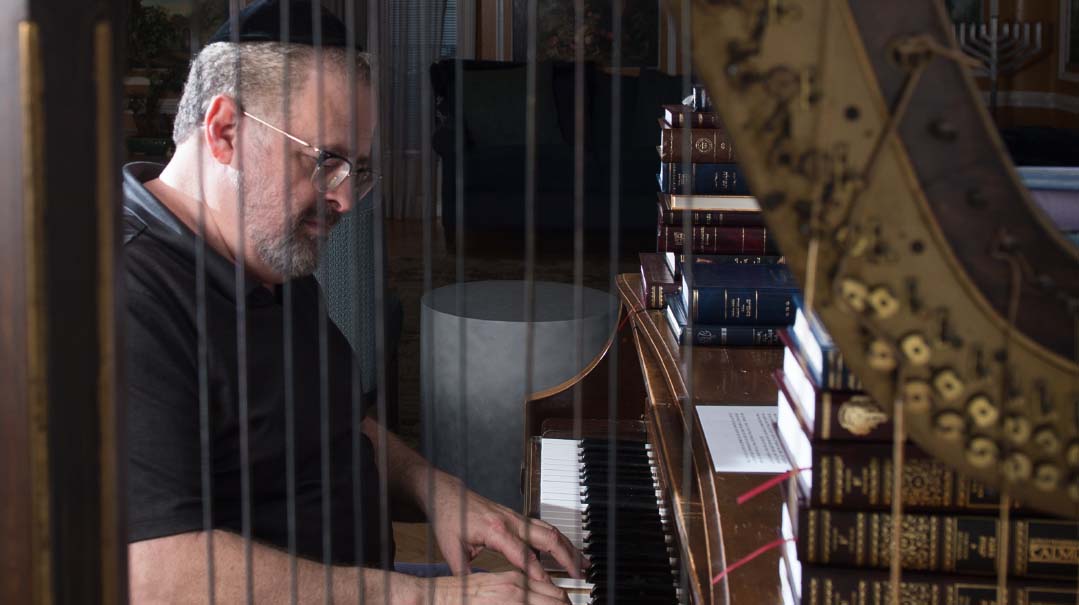Soundtrack of Our Lives

For nearly five decades, Yossi Green’s tunes have been background music as we’ve moved through life

Even before Yossi Green and I get to talking about Yossi Green, we’re talking about Ishay Ribo, whom the veteran composer admires — and his song “Seder Ha’avodah” in particular. I comment that when I first heard it, I found it a bit offensive. The words are sacred, their nusach sacred, recited at the most sacred time of year — is it fodder for artistic expression?
Yossi Green listens politely to my take, and asks a question. “And then what happened?”
I admit at a certain point it grew on me, and I heard something powerful there.
He smiles. “The previous Lubavitcher Rebbe said, ‘Better to look in from the outside then to look out from inside.’ That means it’s better to feel the words, even from the outside, then to be inside and take them for granted. The composer is looking at the words his way, from his place, and sharing what he sees.”
He’s talking about Ribo, but not only.
Many words have been spoken and books written on what it means to be a child of survivors. Yossi Green never delivered a lecture or authored a dissertation on the subject, but instead, he took the range of emotions — pain and surprised triumph, loss, and joy of rebuilding — and created a new type of music, essentially writing the soundtrack to the coming-of-age story of a nation in this particular galus outpost, at this juncture in history.
“It started before the pain,” he tells me. “Pain wasn’t the first stage.”
He recalls the many numbered arms in the Satmar beis medrash of his youth and his complete, blissful oblivion about what they represented. Finally, he asked his father why a certain Jew had a number in blue ink tattooed on his arm, and his father, taking the question seriously, suggested that his little Yossel, his ben yachid, ask the man himself.
Yossi approached the gentleman with his innocent question. The man smiled gently. “When I was a child in Hungary, we were among the first families to have a telephone installed,” he explained, “and my mother was worried I would forget the phone number, so she had it printed it on my arm.”
Sitting outside his Seagate home, waves of the Atlantic Ocean lapping at white sand in his backyard, Yossi Green thinks back to that encounter. “It was too soon. No one had come up with a way to tell a story that they themselves weren’t sure was over. There were no words.”
But there was music.
Reb Moshe Green was a Satmar chassid. Before the war, he had been a rav in Temeshvar, Romania. Yossi was born in Israel in 1955, but then his father decided to move to America to be near his rebbe and accepted a position in a Williamsburg butcher shop. In Romania, he and his wife, Sarah Rivka, had two daughters; 18 years later, they had their only son.
Mrs. Green, no less a survivor than her husband, saw a question mark in the eyes of her child, and she knew precisely how to answer it. The answers came in large, square-shaped record sleeves: Shenker. Werdyger. Chabad. Some Beethoven snuck in too.
“There was a Pirchei record that came out when I was about 12 — the one with ‘Ami Maamin’ and a picture of the Kosel on the cover, an original painting by Yisroel Lamm. Some of the Williamsburg buyers took it home in a brown paper bag, to keep the Kosel image out of sight of anyone who might have been offended by it.”
The songs on many of these albums were of a certain style. “It was like a timid, hopeful, broken tefillah, you could hear what we’d just went through and the theme to every song was the same. Send Mashiach. There’s no other plan and no way to survive.
“Actually,” he muses, “Chabad was a step ahead. They had already started suffering before the rest of European Jewry — they had been oppressed for so long, so you could already hear the fighting spirit in their music.”
Deep inside, Yossi Green lived a song built on what he was hearing, but the chords were just a bit different.
Oops! We could not locate your form.







